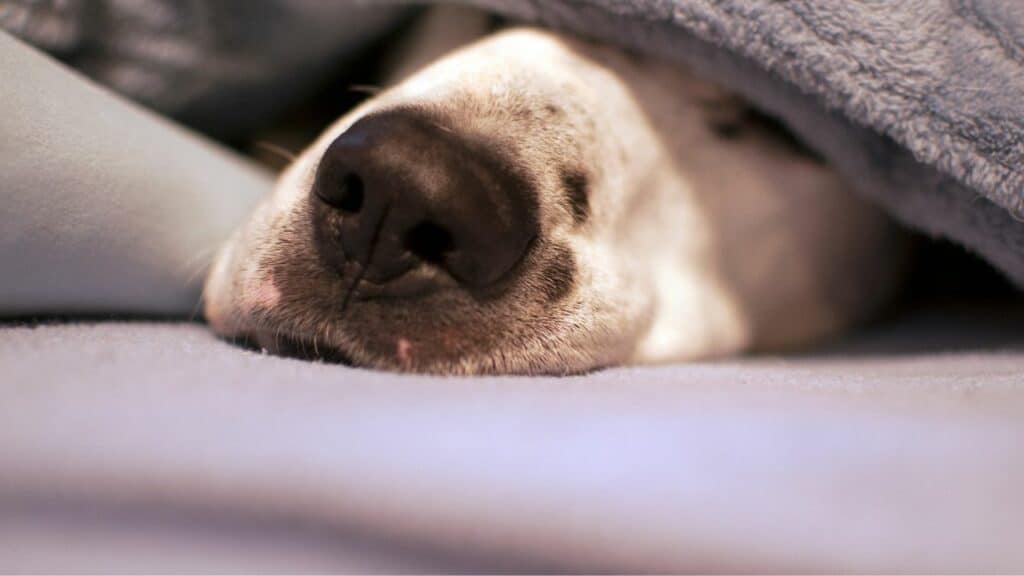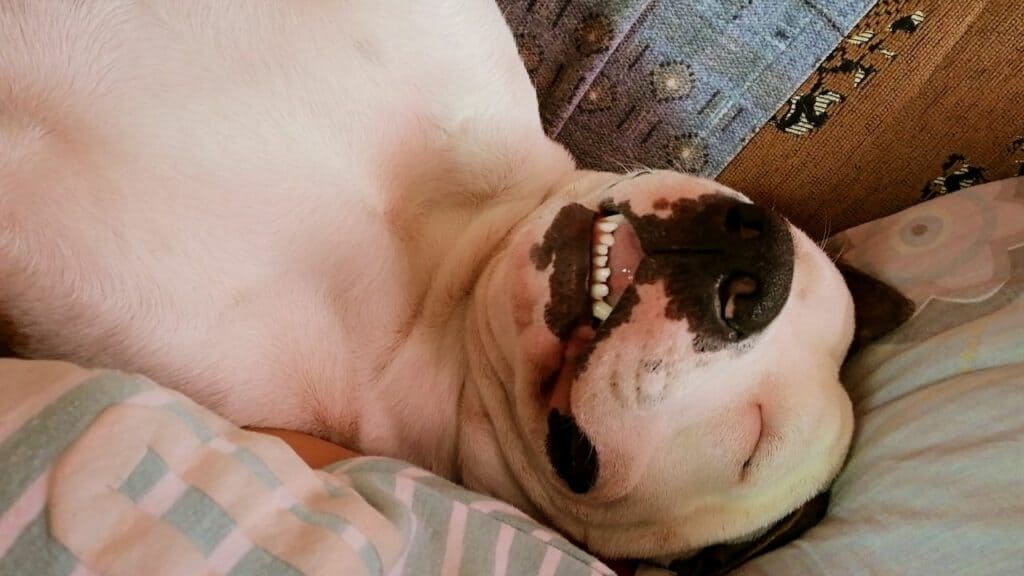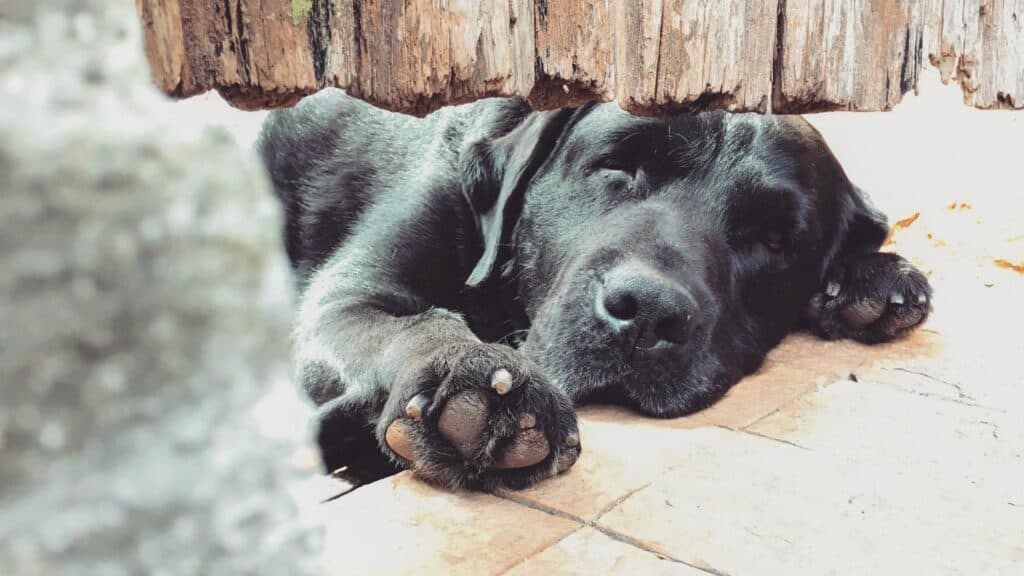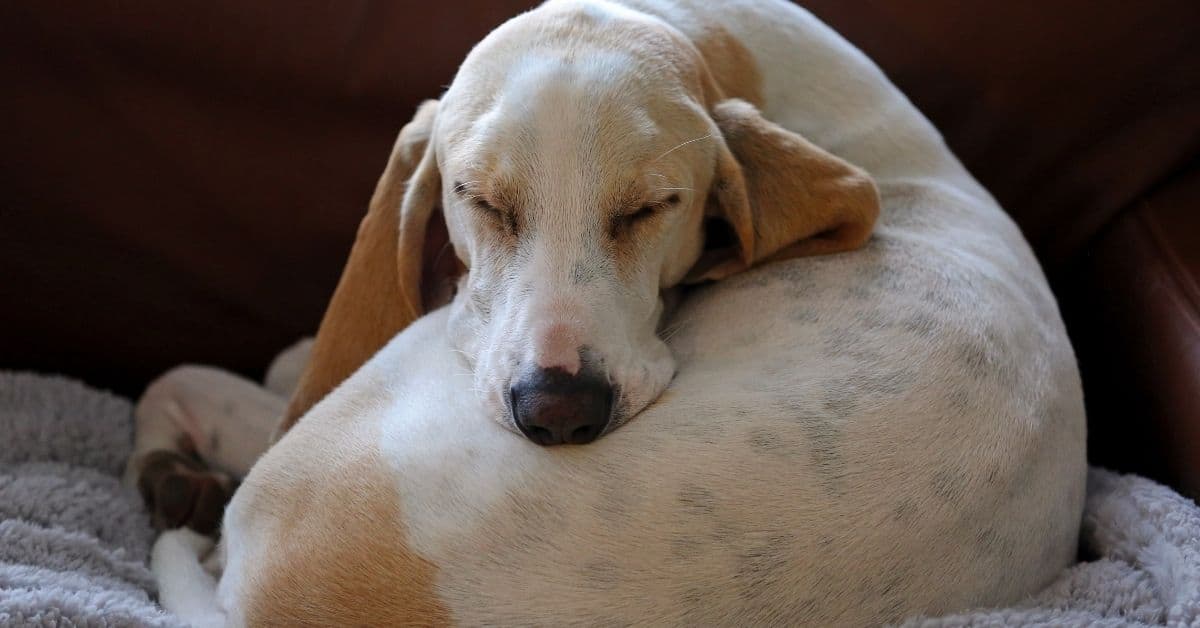Do you ever feel like your dog knows exactly when it’s bedtime?
Or have you noticed them getting agitated or anxious in certain situations?
Well, your pup might be trying to tell you something – and that message could be in their sleeping behaviors!
Just like humans, dogs also exhibit various sleeping behaviors, each with a unique meaning.
In this article, we explore the dog sleeping behaviors and what they mean about your dog’s overall well-being.
Burrowing

Burrowing is a common dog sleeping behavior where dogs like to dig, crawl or burrow under blankets or pillows to create a cozy, den-like sleeping environment.
This behavior is common in breeds like Dachshunds, Terriers, and other small dogs with a history of burrowing for hunting or protection.
Burrowing gives dogs a sense of safety and security as it recreates the feeling of being in a small, enclosed space similar to a den.
By burrowing, dogs can also regulate their body temperature, which can help them stay warm during cold weather or cool during hot weather.
Burrowing is a natural behavior for dogs , and it is often seen in puppies who like to snuggle up with their mother and littermates.
It is also a sign that the dog is comfortable in their environment and feels safe and secure in their sleeping area.
However, it is important to ensure that your dog’s sleeping area is safe and comfortable.
Most important is that they are not at risk of getting trapped or overheated while burrowing.
Twitching
Dogs often twitch in their sleep, which may indicate dreaming and a normal part of the sleeping process.
Twitching usually occurs during REM (rapid eye movement) sleep, the deepest sleep stage.
During this time, dogs’ brain waves can become active.
This causes physical manifestations such as twitching, pawing, or moving their legs as if running.
This twitching is usually not a cause for concern but could indicate certain medical conditions, such as seizures.
If you notice that your dog’s twitching is frequent or excessive, it may be worth checking in with a veterinarian to rule out any underlying problems.
Shaking

Shaking is a dog sleeping behavior where dogs may tremble, twitch, or shiver while they sleep.
Although shaking can be a normal part of sleep behavior, it can also be a sign that the dog is experiencing a nightmare or other negative dream.
Just like humans, dogs can dream while sleeping, and they may experience various emotions, including fear or anxiety.
When a dog has a nightmare, it may shake or tremble as a physical response to the emotions they are experiencing in its dream.
While shaking during sleep is often harmless, it’s important to pay attention to the context of the shaking.
If vocalizations like whining or whimpering accompany the shaking, it could be a sign that the dog is distressed.
In this case, comforting the dog and reassuring them they are safe is important.
Let’s say that the shaking is accompanied by other signs, like trouble breathing, drooling, or seizures.
In that case, it could be a sign of a more serious health condition, and you should seek veterinary attention immediately.
Shaking during sleep is a normal dog sleeping behavior.
But it’s important to monitor your dog’s behavior and seek veterinary attention if you notice any unusual symptoms or changes in their sleep behavior.
Vocalizing
Dogs often vocalize when they’re sleeping, as it is a way for them to express their emotions and communicate with others.
Vocalizing can range from quiet whines or sighs to louder barks and growls.
This behavior is usually a sign of contentment or excitement but can also be caused by anxiety and stress.
If you notice your dog is vocalizing excessively, it could be a sign that they are feeling overwhelmed.
If this is the case, try to provide them with a calm and secure environment to help them feel more relaxed.
Additionally, it’s important to make sure your pup has enough exercise and mental stimulation throughout the da.
This can help reduce stress levels.
Chasing
This behavior can occur when a dog is dreaming, and it may make running or chasing motions with its legs as if they were in pursuit of something.
This behavior is thought to be a result of the dog’s dream content, which may be influenced by their daily experiences, memories, and natural instincts.
Dogs are known for their love of play, and they may dream about chasing balls, playing with other dogs, or even chasing wild animals in their dreams.
It’s important to note that not all dogs exhibit this behavior while sleeping, and some may not show any outward signs of dreaming at all.
Additionally, while dreaming is a normal part of the sleep cycle for dogs, excessive movement or vocalization during sleep could indicate a sleep disorder or other underlying health issues.

Snoring
Snoring is a common occurrence when it comes to sleeping behavior in dogs.
Snoring is caused by air passage obstruction, which results in vibration of the soft palate tissue and produces the familiar snoring sound.
The most common reason for snoring in dogs is the narrowing of their airways due to excess bulk around the throat area.
This can be caused by obesity, thick fur, or even a condition such as a collapsed trachea.
Snoring can also be caused by the dog’s sleeping position and other obstructions in the throat area.
Dogs that sleep on their back, with their throats horizontal to the ground, are more likely to snore than those that sleep on their sides.
If your dog is snoring and you are concerned, it is best to consult with a veterinarian to rule out any serious medical problems.
Stretching Out
Stretching out is a common dog sleeping behavior where the dog lies on their side or stomach and stretches their body and legs out as far as it can.
When a dog stretches out, it may expose its belly, which is a vulnerable area of the body.
This position is a sign that the dog is relaxed, comfortable, and feels safe in their sleeping environment.
Stretching is also a way for dogs to release tension and stiffness in their muscles after a period of inactivity.
Some dogs may also stretch out to cool down if they are feeling too warm, as this position allows for greater heat dissipation.
Overall, stretching out is a natural and healthy sleeping behavior for dogs, and it is a good sign that your furry friend is getting the restful sleep they need.
Spooning

Spooning is a dog sleeping behavior where dogs sleep in a curled-up position with their body pressed against another dog or their owner.
The dog curls up and aligns their body with the body of their companion, often with their head resting on the other dog’s back or its owner’s side.
This position is similar to how humans sleep when they are spooning.
Spooning is a sign of affection and a desire for physical closeness.
It is also a way for dogs to feel safe and secure, as they feel protected by the presence of their companion.
Dogs may spoon with their littermates, other dogs in the household, or their owners.
Spooning is often seen in dogs that are well-bonded and have a strong attachment to their companion.
It is also common in breeds that are known for being affectionate and cuddly, such as Labrador Retrievers and Golden Retrievers. However, not all dogs enjoy spooning, and some may prefer to sleep alone or in a different position.
Overall, spooning is a healthy and natural dog sleeping behavior that indicates a strong bond between the dog and its companion.
It is a sign that the dog feels safe, secure, and loved.
Licking Lips And Paws
Dogs may lick their lips and paws while sleeping for a variety of reasons.
Here are some of the common ones:
- Dreaming: Dogs, like humans, dream during their sleep. Sometimes, the dreams can be intense and lead to physical responses, such as licking their lips and paws.
- Stress and Anxiety: Dogs may lick their lips and paws in their sleep as a response to stress and anxiety. This behavior can be a result of a stressful event or anxiety-inducing situation that happened during the day.
- Dryness or Irritation: Dogs may lick their lips and paws in their sleep to relieve dryness or irritation. For instance, if a dog has a dry mouth or skin irritation, licking can help to alleviate the discomfort.
- Habit: Dogs, like humans, can develop habits, and they may lick their lips and paws as a habitual behavior even when they are asleep.
It is important to observe your dog’s behavior during the day and consult with a veterinarian if you notice any significant changes in their behavior or if the licking becomes excessive or compulsive.
Wandering

Many pet owners have seen this strange thing happen over the years, and researchers have started to figure out why this is happening.
First and foremost, dogs may wander in their sleep because of deep-rooted instinctual behavior.
Wolves have been known to patrol and protect their territories, sometimes even when sleeping.
This same behavior could be seen in domesticated dogs as a remnant of their ancestral past.
Other possible explanations for this wandering include separation anxiety, which can lead dogs to seek comfort in unfamiliar places.
Additionally, instinctual urges such as the need to explore and scavenge for food could cause a dog to wander during its sleep.
Regardless of the reason, pet owners need to be aware of this sleeping behavior to keep their furry friends safe.
Hogging The Bed
Dogs hogging the bed is a very common behavior among our four-legged friends.
While this may seem annoying to some, it’s important to remember that this behavior is rooted in instinct and can often indicate your pup’s mental and physical health.
One of the primary reasons dogs hog the bed is to stay warm.
By sleeping close to their human, dogs can conserve body heat and stay cozy at night.
Additionally, some breeds can be more inclined to do so due to their naturally thick fur or extra-fluffy coatings.
Now that you know more about why dogs sleep the way they do, you can hopefully get a better night’s rest yourself!
If your dog is exhibiting any of the behaviors, we talked about that concern you, don’t hesitate to contact your veterinarian.
They will be able to help you determine if there is an underlying health condition causing the behavior and offer treatment options.

Related Articles
Dog’s sleep is unique, so are the behaviors you learned about now.
If you want to learn more, read the following articles too!


